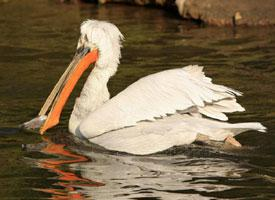
Poids et mesures
| Longueur | de 1,6 à 1,8 m |
|---|---|
| Poids | de 4 à 10 kg |
| Envergure des ailes | de 2,3 à 2,5 m |
Données biologiques
| Durée de vie | 25 r |
|---|
Description de l'animal
The Australian pelican (Pelecanus conspicillatus) is a captivating bird species renowned for its remarkable features and widespread presence across the waterways of Australia, as well as parts of Papua New Guinea, Fiji, Indonesia, and occasionally New Zealand. This species stands out not only for its sheer size but also for its distinctive physical characteristics and intriguing behaviors, making it a subject of fascination for both ornithologists and nature enthusiasts alike.One of the most striking features of the Australian pelican is its enormous bill, which is the longest of any bird in the world. This impressive appendage can reach lengths of up to 50 centimeters (20 inches) and is equipped with a large, flexible throat pouch. The bill is predominantly pale with pink, blue, or yellow hues, and the pouch, used for catching and draining water from its prey before swallowing, can stretch to hold multiple liters of water. This unique tool is essential for the pelican's feeding strategy, allowing it to scoop up fish, amphibians, and sometimes even small birds with remarkable efficiency.
The Australian pelican's plumage is predominantly white, with black markings along the wings and tail. The contrast is striking when the bird is in flight, revealing a wingspan that can extend up to 2.5 to 3.4 meters (8.2 to 11.2 feet), making it one of the largest flying birds. This extensive wingspan aids in the pelican's ability to soar gracefully for long distances, utilizing thermal updrafts to conserve energy during flight. The bird's eyes are surrounded by a patch of bare skin, which can vary in color from pink to yellow, and its legs and webbed feet are generally a pale grey or pinkish hue.
Australian pelicans are highly social birds, often found in large flocks. They exhibit fascinating cooperative behaviors, especially during feeding, where groups of pelicans will work together to herd fish into shallow waters for easier capture. This strategy not only highlights their intelligence but also their reliance on communal interactions for survival.
Breeding behavior in Australian pelicans is equally intriguing. They are colonial nesters, with breeding seasons triggered by the availability of food, rather than a fixed time of year. Nests are typically shallow depressions on the ground, lined with vegetation and feathers. Females usually lay 1 to 3 eggs, which are incubated by both parents. The chicks are born altricial (helpless) and depend on their parents for food and protection until they are ready to fledge.
The Australian pelican's diet is predominantly fish, but it is known to be opportunistic, occasionally eating crustaceans, tadpoles, and even other birds. Its ability to exploit different food sources and habitats, including lakes, rivers, estuaries, and coastal waters, has enabled the species to thrive across a broad range.
Despite facing threats from habitat destruction, pollution, and entanglement in fishing gear, the Australian pelican is currently classified as Least Concern by the International Union for Conservation of Nature (IUCN). This status reflects the bird's widespread distribution and large, stable population. However, continued conservation efforts are essential to ensure that this iconic species remains a prominent feature of the Australian landscape and beyond.
In summary, the Australian pelican (Pelecanus conspicillatus) is a remarkable bird, notable for its size, distinctive bill, and complex behaviors. Its adaptability and widespread presence underscore its importance in diverse aquatic ecosystems, making it a vital species for ecological balance and a symbol of the natural beauty found within the Australian region and its neighboring territories.
Animaux similaires
Nouvelles photos d'animaux
Top 10 des animaux
- Dolphin gull (Leucophaeus scoresbii)
- Diana monkey (Cercopithecus diana)
- Moustached guenon (Cercopithecus cephus)
- Galápagos tortoise (Geochelone nigra complex)
- Russian tortoise (Testudo horsfieldii)
- Stone loach (Barbatula barbatula)
- Japanese macaque (Macaca fuscata)
- Common flying dragon (Draco volans)
- Greek tortoise (Testudo graeca)
- Vendace (Coregonus albula)


